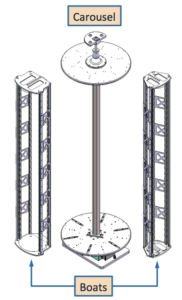 As 3D integration technologies become established in low volume manufacturing, the supply chain is gearing up to address high volume manufacturing challenges so that ultimately, these technologies can be used in consumer products. Cost is king, and industry-wide efforts are focused on lowering it. We talk a lot about optimizing technology on 3D InCites, but we don’t often look at what can be done to lower cost of ownership through supply chain avenues. Genmark Automation, manufacturer of automation solutions for semiconductor manufacturing and related industries, introduced the CODEX Stocker this week that, among other applications, is suited to do just that. In this interview, 3D InCites speaks with Carl McMahon, EVP worldwide sales and marketing, Genmark, about this new offering, and how it fits in the 3D IC supply chain.
As 3D integration technologies become established in low volume manufacturing, the supply chain is gearing up to address high volume manufacturing challenges so that ultimately, these technologies can be used in consumer products. Cost is king, and industry-wide efforts are focused on lowering it. We talk a lot about optimizing technology on 3D InCites, but we don’t often look at what can be done to lower cost of ownership through supply chain avenues. Genmark Automation, manufacturer of automation solutions for semiconductor manufacturing and related industries, introduced the CODEX Stocker this week that, among other applications, is suited to do just that. In this interview, 3D InCites speaks with Carl McMahon, EVP worldwide sales and marketing, Genmark, about this new offering, and how it fits in the 3D IC supply chain.
The Back Story
Genmark Automation is the typical Silicon Valley success story. It was founded in 1985 in a San Mateo garage by husband and wife team, Mila and Genco Genov, natives of Bulgaria. The company grew from an unsophisticated automation company to one that utilizes complex robotics and can be found across the footprint of automation from the front-end, through to the back-end and end-user space. The company’s capabilities extend from handling ultra-heavy LED modules, to shrinking device sizes, to incredibly warped, ultra-thin wafers in the back end.
Initially, Genmark automation systems were integrated into process equipment platforms, and served a primarily OEM customer base. But, McMahon explained, as OEM consolidation continues, the company is shifting focus to a balance of OEM, IDMs, and OSATS to address market peaks and troughs, and smooth out the growth curve. As such, this week at SEMICON West, they are introducing the CODEX Stocker, a stand-alone automated handling system that integrates metrology, stocking and sorting into one system, apart from processing tools.
Taking it Vertical
According to McMahon, Genmark took a careful look at industry trends when designing the CODEX Stocker, which handles a variety of substrates of various materials, shapes, and sizes from 2” to 450mm.
“First, we looked at how we are utilizing space differently than in the past,” he said. “Fab real estate total build costs $2000/sq. ft.. If we go up, we can use smaller footprints and generate more revenue.” McMahon talked about the Internet of Things (IoT) trend that’s driving a need for added capacity in 200mm fabs. He said there are 580 200mm fabs worldwide that are looking to add capacity in the range of $9B-22B over the next 5 years, according to analysts. The industry hasn’t seen numbers like that since 2001. “Bricks and mortar is the problem,” he noted, “by going vertical we can get substrates off the floor. Additionally, we integrate data analytics, RFID tracking and collating to know what’s going on with the substrates. Fab managers know that these are not revenue generating tools. By going vertical we take this equipment off the floor and free up space for revenue generating capital equipment.” Not many companies integrate stocking and sorting into one system, he added. Additionally, the CODEX Stocker is the only handling system that offers metrology as an add-in, which allows for metrology, sorting, and stocking to be integrated into one location, further saving fab floor space and improving revenue opportunities.
Enabling HVM 3D IC Manufacturing
So how can the CODEX Stocker be implemented to lower the cost of 3D IC manufacturing? First of all, McMahon was clear in pointing out that this tool is market agnostic. It was developed to provide automation solutions to customers with complex problems. It can handle/sort/stock wafers, modules, odd form substrates, and even reticles. Specific to 3D integration, the tool suits the varied handling and cleaning requirements that come with TSV fabrication, as well as the lack of standards set for interposer integration and 3D ICs.

One specific example is how this tool addresses the cost of temporary bond/debond. McMahon explained that the integrated metrology allows users to inspect the wafers and determine which need to be scrapped or recoated, and even which vendors provide a better product. The boat system allows customers to then build a library of well-collated glass carrier wafer profiles to essentially create a “golden boat of glass wafers” that have improved lifetimes and profiles. “This provides an opportunity to improve yield by providing more control over the next steps in the process,” explained McMahon. There is already a customer with this system running, and several at the configuration stage, he noted.
“This product can drive down cost of ownership, improve overall visibility of what’s stored as media, collate and sort, and improve potential yield,” said McMahon.
As 3D hits volumes, McMahon says automation is critical. There are lots of manual processes in R&D that need to be automated to meet the demand of increased capacity and rapid time to market. Apple products, for example, run on a 6-8 month life cycle, so design, build and test has to happen quickly. Labor is the #1 cost in HVM. Automation is ideal for repetitive, predictable tasks. McMahon’s recommendation? Give the predictable, repeatable tasks to the machines and let the people work on the value-add tasks where creativity is important. ~ F.v.T
You can learn more about the CODEX Stocker this week at SEMICON West. Contact carlm@genmarkautomation.com to arrange a meeting onsite in the Impress Lounge @Samovar.























